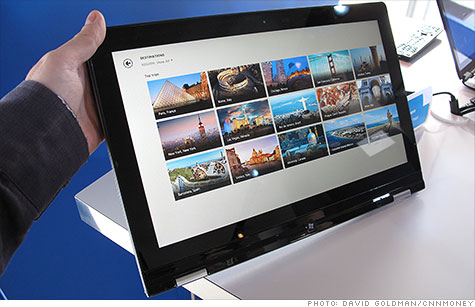
"Thin," "touch-enabled," "light-weight," "beautiful" and "appealing" aren't adjectives usually associated with personal computers -- but get ready. A new wave of ultrabooks and tablets coming this fall are about to change how the world perceives the PC.
At a demo event in New York on Tuesday, Intel (INTC, Fortune 500) showed off more than a dozen new ultrabook designs that are slated to go on sale later this year. They look like the same thin, light laptops as the first generation of ultrabooks, but Intel's new 22 nanometer "Core" processors enable a crucial new feature: touch.
Microsoft's (MSFT, Fortune 500)soon-to-be-released Windows 8is touch-centric, favoring fingers as input devices over keyboards and mice.
That's why Intel designed a touch-enabled ultrabook in its Silicon Valley headquarters last year and it sent it off to PC makers as a reference design to replicate.
Many manufacturers simply added touch capabilities to the screen, but others were more creative. Asus designed a convertible ultrabook with two touchscreens -- one on the front and back of the lid -- allowing the device to fold up and become a tablet.
Lenovo came back with a blast from the past.
Before Apple's (AAPL, Fortune 500) iPad debuted, tablet computers were often laptops with keyboards that folded back behind the screen. They never took off, partly because of their bulk and poor touch capabilities. Now that the technology is vastly better and devices can be slimmed down, Lenovo is trying again with the Yoga.
No comments:
Post a Comment